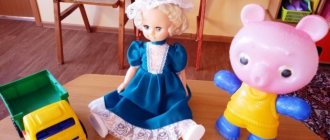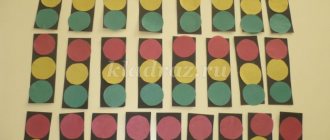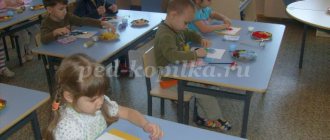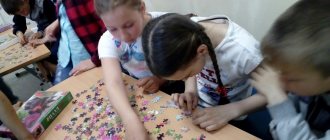Topic: Make whatever toy you want as a gift for a friend.
Yulia Zhdanova
Topic: Make whatever toy you want as a gift to a friend.
Program objectives: Continue to develop figurative ideas and aesthetic perception. Cultivate attention to other children , a desire to take care of them.
Reinforce previously learned modeling techniques. Progress of the lesson. At the beginning of the lesson, ask the children about toys toys they have , which ones they like to play with. And how happy everyone is when they are given toys . You can pay attention to the toys standing in the group .
Remind children that they need to think about the shape and color of your toy . We discuss with the children who wants to make what kind of toy .
Physical education minute. We're tired, we've been sitting too long. We wanted to warm up. We put aside all our business and started charging. Then they looked at the wall. Then they looked out the window. Right, left, turn, and then turn. Let's start squatting. Don't rush to squat. And we sat down for the last time. And now they sat down.
If necessary, help children choose the right modeling techniques. During the sculpting process, clarify the techniques and the name of the sculpting form.
At the end of the lesson, consider with the children what they have sculpted and talk about the sculpted images.
Summary of educational activities “New Year's gift” Purpose: Creating conditions for the cognitive and speech development of children through a gaming situation. Objectives: Correctional - educational:.
“Cut out and paste whatever toy you want” (In the world of fairy tales and cartoons) Summary of an open lesson on appliqué on the topic: “Cut out and paste whatever toy you want” (In the world of fairy tales and cartoons) in the middle group. Didactic game “Make Tin the Snowman” Author’s didactic game for senior preschool age “Make Tin”, presented by teacher O. N. Skvortsova, MBDOU No. 21, Novopokrovsky village.
What kind of music should my child listen to? What kind of music should a child listen to? Today, parents pay less and less attention to what kind of music their child listens to when remembering.
Abstract of a collective creative activity using ICT “Gift to a friend” for children of the older group (5–6 years old) Integration of educational areas: • “Cognitive development”, • “Artistic and aesthetic development”, • “Social and communicative.
GCD summary for junior group 2. Artistic creativity (drawing). Topic: "Let's smile at each other." GCD summary for junior group 2. Artistic creativity (drawing) “We will smile at each other.” Goal: Expanding children's active vocabulary.
Summary of GCD in the preparatory group “If you want to be healthy. A visit to an otolaryngologist" Summary of educational activities in preparatory group No. 1. Topic: If you want to be healthy (visit an otolaryngologist). Goal: clarify and expand ideas.
OOD abstract for application Topic: Creating a collage “Gift for Moms” MUNICIPAL AUTONOMOUS PRE-SCHOOL EDUCATIONAL INSTITUTION BOLSHEALEKSEEVSKY COMBINED KINDERGARTEN “KALINKA” STUPINSKY.
Summary of the circle lesson “Give each other kindness” for children of senior preschool age Topic: “Wonderful old man” Summary script of the circle lesson Direction: cognitive. Age of pupils: Children of the preparatory school group 6-7 years old, in number.
GCD in the middle group “Gift for a friend” SYNOPSIS of GCD in the middle group on the topic “Gift for a friend”. Educational field “Artistic and aesthetic development” (non-traditional techniques.
Source
Modeling a pineapple parrot
First you need to roll out a large orange oval and four short green “sausages”. From an orange oval we will mold the body of a parrot, and from green plasticine we will make tufts.
Make a lot of dents in a stack on the oval, as shown in the picture. These indentations will represent the parrot's feathers. Make sharp leaves from green sausages and attach them to the top of the pineapple parrot's head.
Next we need blue color and make a thin flat oval out of it. Stick this oval on the “pineapple” (the parrot’s body) in the place where the parrot’s eyes will be. Stick a beak of red plasticine on this oval and make eyes. For the eyes, first use white plasticine, making round cakes out of it, and then black - smaller cakes for the pupils.
Now it's time to make the pineapple parrot's wings. We will also make the wings from blue plasticine. two wings and decorate them with slits using stacks. The wings need to be stuck on the sides of the “pineapple”.
We will make the paws from orange plasticine. Sculpt two legs and place the finished pineapple parrot on top of them. You should press it lightly against the paws so that they are connected and cannot fall off when you move it.
There are many representatives of birds in the world, but is it possible to see a bird more colorful than a parrot? For example, a representative of this species is the macaw. The plumage of this large bird probably contains all the colors of the rainbow. These are mainly red and blue colors, but there are others. Parrots are full-fledged members of the family if they live in a house. Their cheerful chirping, and sometimes conversations, are simply touching. Birds repeat certain words after humans with particular enthusiasm; it looks funny and unusual. We suggest making a small figurine of a bright parrot with your own hands together with the children. You can complete the work according to the instructions given.
Materials for sculpting a parrot:
- bright plasticine;
- plastic tool.
Summary of GCD for modeling “Our Favorite Toys” in the middle group
Purpose of the lesson: to teach children to work with plasticine; sculpt various
objects, conveying their shapes, proportions, poses.
Teach children to sculpt familiar objects - toys , convey their characteristic features, consolidate knowledge about the properties of plasticine;
develop skills in organizing the workplace;
develop cognitive interest in creativity, imagination;
friendly attitude towards each other;
develop fine motor skills;
Cultivate accuracy and attentiveness;
Instill love for the world around us.
Preliminary work: reading poems about toys , riddles about toys , drawing toys .
Equipment and materials: pyramid toy , plasticine, plasticine board.
How to make a Macaw bird?
The Macaw parrot is a fairly large species. For naturalness, the plasticine figure itself also needs to be made large. During the sculpting process you will need:
plasticine of different colors - blue, yellow (large volume), a little brown, black and white;
The head and body must be sculpted in the same way as in the first version. To do this you need to use yellow plasticine. When the oval body is ready, you need to use the same principle to make white cakes, a beak and eyes to decorate the muzzle.
The parrot needs to have a so-called crest on its head. To do this, you need to roll a ball of blue plasticine, flatten it and cut it from one edge using scissors. The result should be some kind of fringe. The crest is fixed on the head.
Next, using the already known technique, you need to make the tail and wings. Only in this case you need to use two colors: blue and yellow. The last one will be on the bottom, and the blue one will be on top. The tail must also be cut using scissors into several wide strips.
At the final stage, you need to take brown plasticine and make paws from it.
Modeling. My favorite toys!
Topic:
Modeling
.
My favorite toys!
Educational area
: “Artistic creativity.”
Integration of educational areas
: “Reading fiction”, “Communication”, “Labor”, “Physical education”, “Communication”. Types of children's activities: productive, cognitive-research, communicative, motor.
Form of organization:
subgroup.
Target:
teach the technique of creating an image of a “toy” on a plane in half volume using plasticine.
Tasks:
- consolidate the ability to create the integrity of an object from individual parts, using existing skills: pressing parts to the base, smearing, smoothing the boundaries of the connection of individual parts; — expand children’s knowledge about toys, teach how to write a descriptive story, select an action to an object, develop fine and gross motor skills, memory, and sensory areas; - cultivate a caring attitude towards toys.
Preliminary work
: reading a fairy tale by G.Kh. Andersen's "The Steadfast Tin Soldier", educational game "Guess the Toy", riddles about toys, drawing toys.
Material and equipment:
— cardboard with images of toys, size A-4; - a set of plasticine; - modeling board, stack; — paper and wet hand wipes; — projector, presentation on the topic; - toys.
Progress of direct educational activities
1. Organizational moment.
- Guys, today we will draw with plasticine, but guess what?
(Toys.) - Yes, I asked each of you to bring your favorite toy and introduce us to it. Children take turns coming out, showing their toy, reading a poem: 1 child:
Here is a funny fat bear, He is my friend, not a little naughty boy.
He has a bow on his neck. Well, Mishutka! What a dandy! - What is your bear? (Soft, brown, fat, funny). Why do you love him? 2nd child:
He has big ears, He is brown, Everyone in the world loves him, Every mongrel knows Gena’s Friend, Cheburashka.
— Describe your Cheburashka. Why is this your favorite toy? 3rd child:
Well, this is Tumbler, the Multi-colored cutie.
Swing it right, left, and put it on the shelf. - Tell me about your toy. Who gave it to you and when? Child 4:
The cubes are always in front of me.
Build a tower out of them. And then a huge house for an old gnome to live in. - What, do you like to build with cubes? Child 5:
Here is my favorite ball, It is always with me now.
Jumps and spins Jumps and spins! - What is your ball? (Round, rubber, multi-colored). — What ball games do you like to play? 6th child:
I will assemble a pyramid from multi-colored circles, and then I will remove the top and scatter it on the carpet. — How many rings does your pyramid have, and what color?
2. Main part.
Conversation.
- From birth, each of you has toys, but guess what the very first one is:
If you touch it, it will immediately rattle and surprise the baby.
What is this bright toy? - For the baby... (rattle) - Like today, a child’s first toy in ancient times was also a rattle. In Ancient Greece and Rome, rattles were given to newborns. Mothers sang lullabies while tapping these rattles. It was believed that with their noise they drive away evil spirits from the child. (1 slide). — Ancient Russian toys appeared in the 9th century. They were made of wood and clay, called nursery rhymes. These were wooden horses, cows, deer, swans, birds and other objects. They were used both for games and as talismans. For example, the Russian traditional grain doll, which was given as a gift for holidays associated with the harvest. (2 slide). — The very first animal figurines were carved from bone, and later made from wood, clay or metal. Toys were sewn from fabrics or woven from fiber, and made from any suitable available materials. There were known toys with movable body parts, which have been made since ancient times. They were driven by a simple rope or wire mechanism. — Previously, toys were treated with great respect. They were never left haphazardly, but were stored in special baskets or chests. Moreover, they not only played with toys, they participated in many rituals: honoring dead ancestors, worshiping ancient gods, and also acted as amulets. — Nowadays, toys are made in special factories. These are bright, modern toys that can talk, sing, jump, take off, and drive independently. They are made from a variety of materials, which ones? (Wood, plastic, iron, rubber, fabric, leather, paper, clay, dough). - Guys, imagine if there were no toys. (Children's answers.) - Toys decorate our lives, make it interesting and fun. Toys teach us, develop us, help us. How should we treat toys? (Be careful, always put in place). — We will also open our own small factory and make our own toys, but from what material? (Plasticine).
Practical part.
Stage 1.
- I will distribute the finished outlines of your toys, and you prepare the colors of plasticine that you will need.
You can take the same color as your toy, or you can use a different color of plasticine or combine several colors at once. Children think through and express their wishes to the teacher. The teacher encourages children's choice and reminds them of the modeling algorithm. We pinch off a small piece of plasticine, roll it into thin sausages, place it along the contour of the object and spread it in a thin layer. — To get a drawing on a toy, we start working with it. For example, on a ball we first sculpt yellow stripes, and then paint over the remaining 4 parts. The teacher helps each child decide where to start working. Helps during sculpting. Fizkul Tumbler, look, bend it anywhere. (Bending over to exhale, straightening up - inhale.) She will stand up straight again, She is so stubborn. (Tilt to the sides 3 times, back and forth 3 times.) The spinning top began to spin,
don’t spin too fast, (Circular rotations of the body 3 times in one direction, 3 in the other.) That’s enough, everyone stop. Our cheerful ringing ball, Again
it rushed at a gallop.
(Jump 8 times.) The doll Katya suddenly started walking, she stretches her hands towards us. He says it’s time to play, I’m tired of waiting for you here. (Raise your right leg and left hand, then vice versa.) To play with the ball, you need to inflate the ball. (Palms of your hands on your stomach. When you inhale, inflate your stomach, when you exhale, pull your stomach in. 6 times.)
Stage 2.
— Guys, don’t forget about the additional details: eyes, nose, mouth, bow on the bear. To make the toy look “lifelike”, place thin sausages along the contour of the color of your toy.
3. Reflection.
- So our toys are ready.
What kind did you get? (Bright, cheerful, beautiful). — How should you treat toys? - A toy is your friend and comrade, take care and love them. — Let's send our toys to the store (to the exhibition). But first, let’s play the didactic game “What can toys do?”
For example, a car: drives, hums, is lucky, rumbles; ball: flies, jumps, jumps, falls, rolls.
How to make a parrot from plasticine
There are many representatives of birds in the world, but is it possible to see a bird more colorful than a parrot? For example, a representative of this species is the macaw. The plumage of this large bird probably contains all the colors of the rainbow. These are mainly red and blue colors, but there are others. Parrots are full-fledged members of the family if they live in a house. Their cheerful chirping, and sometimes conversations, are simply touching. Birds repeat certain words after humans with particular enthusiasm; it looks funny and unusual. We suggest making a small figurine of a bright parrot with your own hands together with the children. You can complete the work according to the instructions given.
Materials for sculpting a parrot:
- bright plasticine;
- plastic tool.
Christmas gifts
Christmas wreaths are made from plastic bottles, spruce branches with cones. This material is used for bells and Christmas tree decorations.
Funny Santa Claus will be an excellent New Year's craft made from plastic. To do this, you will need to cover the bottom of the bottle with a red compound.
Instead of a belt, colored adhesive tape is attached to the figure. Hair and beard are made from cotton wool. Santa Claus should have a red hat or cap on his head.
All that remains is to glue the eyes or draw them yourself. The nose will be a pink ball. You should add some blush to your cheeks, because the character spent a long time visiting in the cold.




